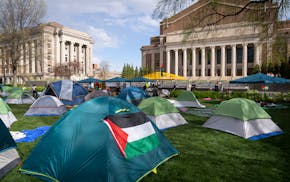A lot of beauty has been on display in Duluth and its environs of late. We're not talking about Lake Superior's odd peachy color, the foamy overfilled rivers and streams, or the many naked swaths on mudslide-scoured hills -- though those are riveting sights.
Rather, the beauty we've admired since torrential rain fell on June 19-20 is the human kind. It's the 400 shovel-toting volunteers who showed up Monday night to clean a beloved park. The 300 who appeared at the hard-hit Lake Superior Zoo last weekend to pitch in. The Red Cross volunteer who lost his home to Hurricane Katrina in 2005 and who spent Tuesday going door-to-door in the Fond du Lac neighborhood to offer aid. The emergency responders who've worked around the clock to protect unwitting citizens from hazards.
Natural disasters tend to bring out the best in Minnesotans - including legislators. We were cheered to see legislative leaders of both parties jointly touring the flood-afflicted region on Wednesday. They came to see for themselves what an estimated $100 million in public infrastructure damage in Duluth alone looks like -- and, to their credit, to promise that state financial help will be forthcoming.
"Infrastructure is not partisan." That's become something of a mantra for Duluth DFL Sen. Roger Reinert in the last 10 days, as he and his fellow elected officials from the heavily DFL region have appealed to the Republicans who control the Legislature for help.
Every Minnesotan should echo Reinert's message. Duluth and its neighbors experienced 10 inches of rain in 24 hours, on top of 7 inches the preceding week -- a rare but not unprecedented event in Minnesota, and one that climate scientists say is likely to occur more often as the planet warms.
To be sure, the region's unique topography and Duluth's aging infrastructure added to its plight. Mudslide debris from steep hills created mini-dams. Undersized, aging culverts backed up. Sink holes developed as underground creeks carved new channels for themselves. Water hurtled down impervious surfaces on Duluth's famous hill. Both the volume and the velocity of floodwaters created havoc.
But no place in the state would be unscathed after a drenching on the scale Duluth endured -- and any place could be next. Preserving the statehouse tradition of a bipartisan, openhanded response to natural disaster is in everyone's interest.
Minnesotans know natural disasters only too well. Lessons derived from the August 2007 deluge in southeastern Minnesota's bluff country were codified in statute in 2008. That statute is proving its worth now, guiding the 13 state agencies and local governments that share relief responsibilities to meet needs comprehensively while avoiding duplication of effort.
The natural-disaster statute's chief architect, Winona state Rep. Gene Pelowski, said last week that he expects the state's share for the Duluth area floods to top the $135 million the 2007-08 Legislature appropriated for cleanup in his part of the state.
That potential expense is precisely why the state was wise to refill its aptly named "rainy day" fund to its full statutory level, $653 million, as tax collections began to climb out of the recession's trough in the past year. Gov. Mark Dayton did well to stand in the way of the 2012 Legislature's attempt to draw down those funds. Some of them are needed in the Northland now.
Dayton said Friday that he expects to call a special session in late July or early August to authorize payment of the state's share of public infrastructure repair costs. As it has done in the past, state government should cover the entire 25 percent share that the Federal Emergency Management Agency (FEMA) requires of state and local governments. The Dayton administration sent an initial damage assessment of $108 million to Washington Friday. That figure will surely grow in the final analysis.
State officials should look for ways to use Minnesota's relief dollars to not just repair damaged streets and sewers, but to rebuild them to accommodate the changing climate and larger population of the 21st century.
In addition, legislators should consider providing state help in situations for which little or no federal help can be expected. That's likely to include damage to homes and nonprofit institutions, Duluth officials say.
Securing residential aid has proven vexing after previous Minnesota floods, for which few homeowners are insured. That's the case in Duluth and its environs. Help in repairing or replacing flood-damaged homes is "my primary concern," Duluth Mayor Don Ness said last week. State officials should consider not only how best to assist homeowners now, but what policies might make homeowners' insurance a more reliable recovery tool in the future.
Ness -- who has provided impressive leadership in the past 10 days -- and other Duluth officials want Minnesotans to know one thing more: The city is ready and eager for visitors. The tourism-dependent region ought not suffer a double disaster this season because vacationers mistakenly believe that their destination has been spoiled.
Duluth has taken a hit. But most of the city is as beautiful as ever -- and more so because of how its people have responded to the torrent they endured.
---------------
Readers, what do you think? To offer an opinion considered for publication as a letter to the editor, please fill out this form. Follow us on Twitter @StribOpinion and Facebook at facebook.com/StribOpinion.
Store guns safely and save lives

Why we protested at the University of Minnesota


